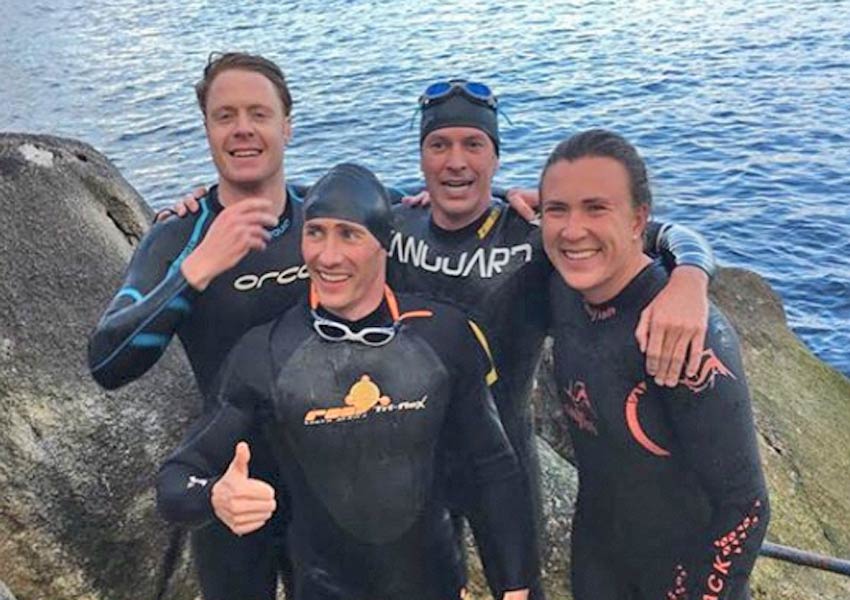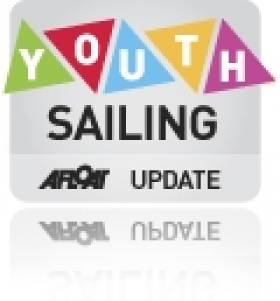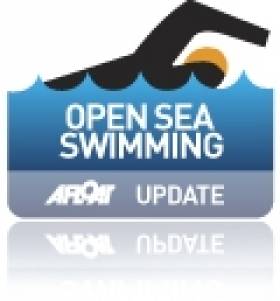Displaying items by tag: cancer
Dublin Bay sailor Guy O’Leary is already a third of the way into his MileADayInMay fundraiser, in which he’s challenging himself to swim a mile each day during the month of May in aid of cancer research.
And this year he will be joined by 70 swimmers both in person and around the world doing their own miles to support his important fundraising effort.
As regular Afloat readers will know, Guy — son of Dun Laoghaire Marina developer and local sailing stalwart Michael O’Leary — was diagnosed with cancer after a routine check-up in November 2017 at the age of 34.
Thanks to the efforts of an “incredible surgeon” and other specialists, not to mention 11 gruelling rounds of chemotherapy, Guy has long since regained his health.
And he’s been determined to give back to those who helped keep him alive — starting with first fundraiser in May 2019 when he swam a mile each day in May in various locations, whether in pools, inland waters or the sea.
“Having been through the horrors of cancer, I want to do everything I can to help the research effort,” Guy says. “Over the past few of years, we have raised enough money to fund 8 years of PhD cancer research.”
For the third year running Guy is fundraising both for cancer research in Ireland, which has garnered more than €12,000 already, and for Cancer Research UK which has raised another £1,900. Follow his progress on Instagram.
Dublin Bay sailor Guy O’Leary is back in the water and challenging himself again to swim a mile each day during the month of May in aid of cancer research.
Each day of the MileADayInMay! swimming challenge will see Guy joined by “someone who helped me through the rough times” to raise funds for Cancer Research UK and Cancer Clinical Research Trust Ireland.
And Guy’s final swim of the month will start outside Dun Laoghaire Harbour, finishing at the Royal Irish Yacht Club slipway.
As regular Afloat readers will know, Guy — son of Dun Laoghaire Marina developer and local sailing stalwart Michael O’Leary — was diagnosed with cancer after a routine check-up in November 2017 at the age of 34.
“My incredible surgeon performed a bowel resection straight away but a subsequent PET scan revealed the disease had spread to my liver,” he says.
“Another major operation, 11 cycles of chemo and many hard days later, I was back on my feet with clear scans and a future I thought I mightn’t have.”

Guy still wants to give back to the “brilliant” charity and the doctors and scientists it supports “who developed the diagnostics, surgical robots and chemo treatments that saved my life”.
He explains: “It is because of the skill of two amazing surgeons, an unbelievable oncologist, my amazing team of nurses, a relentlessly inquisitive wife and the work of Cancer Research that I am still alive today.
“The progress Cancer Research has made over the last three decades means that I was given a chance at survival. This was a chance my grandmother didn’t have when she fell ill with the disease in the mid-1980s.
“Having been through the horrors of cancer, I want to do everything I can to help the research effort.”
Guy has set up a website for his challenge at MileADayInMay.org which links to his fundraising site, and you can also follow his progress on Instagram.
Guy O’Leary’s challenge to swim a mile each day during the month of May has so far raised a whopping €70,000 for Cancer Research UK.
As previously reported on Afloat.ie, Guy — son of Dun Laoghaire Marina developer and local sailing stalwart Michael O’Leary — was diagnosed with cancer after a routine check-up in November 2017 at the age of 34.
Following a lengthy period of treatment, he decided he needed to do something to pay back the medical staff and researchers — not to mention family and friends — whose support means he’s still here today.
That’s where his idea to swim a mile a day in the month of May came about.
Guy began his MileADayInMay! challenge on Wednesday 1 May with his wife Aoife, and as he continued was joined each day by “someone who helped me through the rough times”.
 Guy (left) with Annalise Murphy and friends on Day 27 of his challenge | Guy O’Leary/Instagram
Guy (left) with Annalise Murphy and friends on Day 27 of his challenge | Guy O’Leary/Instagram
These included names familiar to Afloat.ie readers such as Annalise Murphy, the Goodbodys and Kinsale’s Sam Hunt — as well as others with a closer connection to the reason for his challenge such as fellow cancer patient Jim Right Now, and his own oncology nurse Lorna Lee.
Over the month he and his swimming companions braved the chilly waters of Killiney Bay, the more comfortable environs of the Trinity College pool, and even sunny Brockwell Lido and the Olympic pool in London.
And as promised, his final mile started outside Dun Laoghaire Harbour, finishing at the Royal Irish Yacht Club slipway.
“This has been an incredible challenge for me,” he said after his last swim of the month. “Thanks to the 45 swimmers who completed a mile with me and for all the donations so far.”
As of today the total raised stands at are than £62,000 — and Guy’s fundraising campaign is still active for anyone who wants to contribute.
Guy O’Leary Is Swimming A Mile A Day In May For Cancer Research
Guy O’Leary is back on his feet after more than a year of cancer treatment — and to prove it he’s challenged himself to swim a mile each day during the month of May.
Beginning this Wednesday 1 May, each day of the MileADayInMay! swimming challenge will see Guy joined by “someone who helped me through the rough times” to raise funds for Cancer Research UK.
And Guy’s final swim of the month will start outside Dun Laoghaire Harbour, finishing at the Royal Irish Yacht Club slipway.
Guy — son of Dun Laoghaire Marina developer and local sailing stalwart Michael O’Leary — was diagnosed with cancer after a routine check-up in November 2017 at the age of 34.
“My incredible surgeon performed a bowel resection straight away but a subsequent PET scan revealed the disease had spread to my liver,” he says.
“Another major operation, 11 cycles of chemo and many hard days later, I was back on my feet with clear scans and a future I thought I mightn’t have.”
Now Guy wants to give back to the “brilliant” charity and the doctors and scientists it supports “who developed the diagnostics, surgical robots and chemo treatments that saved my life”.
He explains: “It is because of the skill of two amazing surgeons, an unbelievable oncologist, my amazing team of nurses, a relentlessly inquisitive wife and the work of Cancer Research that I am still alive today.
“The progress Cancer Research has made over the last three decades means that I was given a chance at survival. This was a chance my grandmother didn’t have when she fell ill with the disease in the mid-1980s.
“Having been through the horrors of cancer, I want to do everything I can to help the research effort.”
Guy has set up a website for his challenge at MileADayInMay.org which links to his fundraising site, and you can also follow his progress on Instagram.
#sailforcancer – Two Foynes Yacht Club (FYC) Sailors on the Shannon Estuary, Chris Egan and Dave Bevin, will sail around Ireland this summer to raise funds for the Irish Cancer Society.
Both men are facing their own personal Cancer challenges and are determined to do something positive to support the amazing work currently being done by the Cancer Society in Ireland.
Over the summer months, the voyage around Ireland will cover up to 1200 nautical miles and the sailors will be visiting over thirty coastal safe havens, keeping the average distance per day sailed to around 40 nautical miles.
The Royal National Lifeboat Institution are collaborating closely on the planning of the trip the yacht "Inizi" is a 30ft Jeanneau Rush and is currently on the hard stand at FYC and being prepared for the trip.
The yacht will undergo a full RNLI Sea Safety Check before launch. The two intrepid voyagers are experienced coastal and offshore sailors and a third crew spot will be filled in rotation by the members of Foynes Yacht Club as the journey progresses.
A promotion and fundraising organisation will be in place to support the crew of Inizi and will be coordinated by Foynes Yacht Club, the Irish Cancer Society and the RNLI.
This website will be the key hub for all fundraising and communication.
The sailors will publish on the webpage a Cruising Log of each leg. This will give an entertaining and detailed account of the journey and will be of interest to anybody who might take such a trip in the future or indeed to anybody who might simply like to enjoy reading about the experiences of a crew of small boat sailors making their way around the amazing Irish Coast.
Email: [email protected]. Mobile 087 2264661
Ellen MacArthur Cancer Trust Celebrates Busiest Year
But, although surpassing its previous best ever numbers of 250 young people last year, the Trust is already setting its sights on eclipsing the new record-breaking figures in 2012!
The Trust, established by Dame Ellen MacArthur in 2003 to inspire children's recovery from cancer and serious illness, offers opportunities for young people aged eight to 24 to take part in a range of sailing-based activities, including the Trust's traditional four-day Solent sailing trips, longer cruising weeks and week-long outdoor activity residential trips.
The young people are also invited back to take part in other events including the J.P Morgan Asset Management Round the Island Race and given the chance to earn professional qualifications, such as the Royal Yachting Association Competent Crew course, with many returning as volunteers once they turn 18 too.
Having introduced new 18-24 years' specific trips in 2010, 2011 saw the Trust work with 63 young adults from 10 new hospitals (Scotland, London, Cambridge, Cardiff, Birmingham, Manchester, Newcastle, Bristol, Plymouth and Southampton), in addition to the four hospitals (Nottingham, Leicester, Sutton and Leeds) from last year.
Kamal Khalifa, a first time 18-24 years' trip participant from Hendon in North West London, who finished treatment in 2011 for Osteosarcoma, a form of bone cancer said: "The trip was my first time sailing and I was really nervous before the trip, but I'm so glad I went! Everyone was really nice and they do the best to help you. I got to know so many people it was like a little family. The sailing was fun and challenging but the best bit was the evenings when everyone chilled and played games. The team really help to get the most out of the trip for you, even if you have limited movement or if you're tired they will do their best to help."
The Trust also introduced a second residential dinghy trip this year, with 25 eight-17 years olds travelling to Waterpark Lakeland Adventure Centre in the Lake District for 'Northern Dinghy Week'. This trip was launched to give more northern-based young people the chance to do something similar to the Trust's original residential week at Bradwell Outdoor Education Centre in Essex much closer to home.
Waterpark trip attendee Paige Nuttall, who finished treatment for a brain tumour in 2009 said: "After my first trip with the Trust I was really excited about coming back and I was looking forward to everything about the new trip! My first trip made me feel so free and it was really exciting to get back on the water. I have had a fantastic time, met loads of news friends and did things I didn't think I could do."
No fewer than 102 volunteers helped across the 14 trips, with over a quarter of those made up of young people whose first involvement with the Trust came when they themselves were in recovery from cancer or leukaemia.
But Frank Fletcher, Trust Chief Executive Officer, insists despite its 2011 success the Trust will not be resting on its laurels. He said: ""When you see over 300 young people enjoying themselves and gaining so much from the different trips it is almost hard to believe we started as two trips with 15 youngsters. This year we had 51 different crews involved in total!
"None of this would be possible without the unbelievable support we get from our volunteers and the Friends of the Trust. For even more young people to be able to sail with us next year we need our more people to financially support the Trust - a great way to do this is to become a friend of the Trust"
Govt Signs Off On €40m to Clean Up Haulbowline Waste Site
The Government has signed off on a €40 million package to begin clean-up of the toxic waste site on Haulbowline Island in Cork Harbour, the Cork Independent reports.
As previously reported on Afloat.ie, the site at the former Irish Steel/Ispat plant - which closed a decade ago - contains an estimated 500,000 tonnes of waste, including toxic heavy metals and cancer causing materials, and has been blamed for the area's notoriety in having one of the highest cancer rates in Ireland.
The move comes after an ultimatum from the European Commission earlier this year to act on cleanup of the island.
Mary O'Leary, chair of the Cork Harbour Alliance for a Safe Environment (CHASE) lobby group, is cautiously optimistic about the Caninet's move on the issue, but said "the proof of the pudding is in the eating".
She told the Cork Independent: “Obviously we welcome the announcement, we have been fighting for 15 years for this. It is a guarded optimism because we were promised something in 2008. We didn’t see anything then so we will see what happens here."
O'Leary has been invited to join the steering committee that will oversee the cleanup.
“It is in all our interests that a solution is found for the former Ispat site," said Minister for the Marine Simon Coveney, "and I am determined to ensure that there are no further delays in finding a solution."
The Cork Independent has more on the story HERE.
Ronan Keating Battling the Waves in Irish Sea Charity Swim
Singer Ronan Keating set off with a group of celebrities and 'super swimmers' on a charity crossing of the Irish Sea from Holyhead to Dublin late last night.
The former Boyzone star is joined by TV presenters Jenny Frost and Jason Bradbury, writer and psychologist Pamela Stephenson and British Olympic swimmer Steve Parry.
Keating and his group - who all have personal or family experience of cancer - hope to raise £1 million (€1.13 million) for Cancer Research UK.
Each celeb will take turns swimming for one hour until the group reaches landfall in Dublin - a journey that's expected to take 40 hours and could cover as much as 70 nautical miles due to tidal variations.
The Irish Times has more on the story HERE.


































































